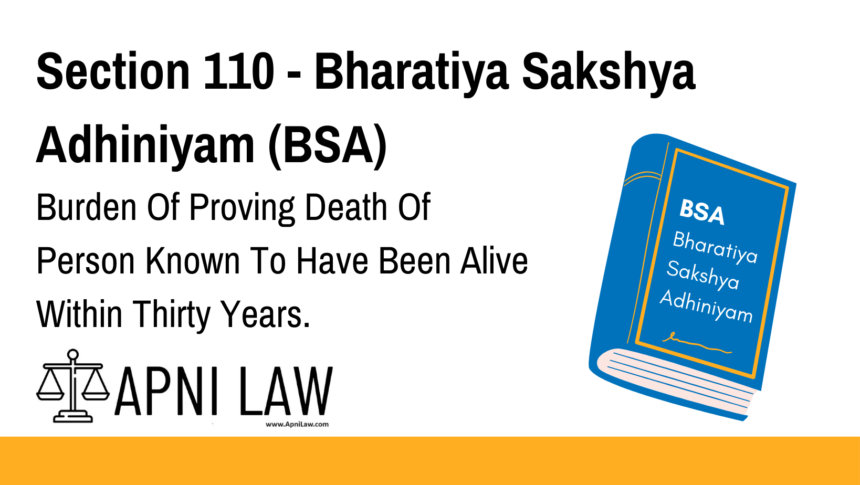Code: Section 110 Bharatiya Sakshya Adhiniyam, 2023
When the question is whether a man is alive or dead, and it is shown that he was
alive within thirty years, the burden of proving that he is dead is on the person who affirms
it.
Explanation of Section 110 BSA
Section 110 of the Bharatiya Sakshya Adhiniyam, 2023 provides a rule regarding the burden of proof when the issue in question is whether a person is alive or dead. If it is established that the person was alive at some point within the last thirty years, the burden falls on the person who asserts that the individual is now deceased.
The rationale behind this provision is rooted in the presumption of life. In the absence of evidence or circumstances indicating death, the law assumes that a person is alive, especially when it can be shown that the individual was alive recently, within the past thirty years. The burden of proving that the person is dead, therefore, lies with the party making that assertion.
Key Principles:
- If it is shown that a person was alive within the last thirty years, the assumption is that they are still alive.
- The person claiming that the individual is dead must provide evidence to prove this fact.
- This provision prevents unwarranted assumptions about a person’s death without sufficient proof, as people may sometimes be missing or out of contact for extended periods.
Illustrations
Illustration 1:
A man was last seen alive ten years ago, and there is no evidence of his death. Now, his family members assert that he is dead. According to Section 110, they must prove his death, even though he was alive within the last thirty years.
Illustration 2:
A company claims that a key witness who was alive 25 years ago is now dead. The company must provide evidence that the person is indeed deceased, as it is assumed that the person is still alive unless proven otherwise.
Common Questions and Answers on Section 110 BSA
- Who has the burden of proof regarding the death of a person?
- The burden of proof lies with the person who affirms that the individual is dead.
- Does the rule apply to any person who has been alive within the last 30 years?
- Yes, this section applies to anyone who has been shown to be alive within the last thirty years.
- What if the person has been missing for many years but was known to be alive within thirty years?
- Even if the person has been missing for many years, as long as they were known to be alive within thirty years, the burden to prove their death lies on the person asserting that they are dead.
- Why is this rule important?
- It ensures that assumptions of death are not made prematurely and that individuals are presumed alive until proven otherwise. This helps prevent potential legal or financial issues that could arise from declaring someone dead without sufficient evidence.
Conclusion
Section 110 of the Bharatiya Sakshya Adhiniyam, 2023 provides an important guideline for cases involving questions of whether a person is alive or dead. By placing the burden of proof on the party asserting that the person is dead, the law ensures that such claims are backed by adequate evidence, especially when the person was known to have been alive within the last thirty years.
This section upholds the principle of presumption of life, ensuring that people are not prematurely declared deceased without proper proof. It serves as a safeguard in legal proceedings to avoid the wrongful assumption of death.
For further understanding of legal provisions related to evidence and the law, visit ApniLaw.








